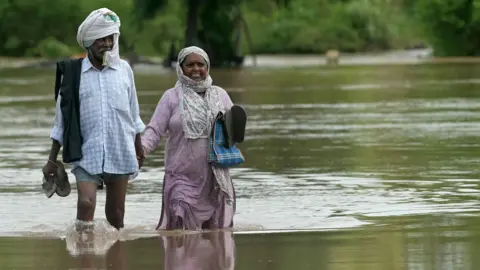Heavy monsoon rains have recently pounded Pakistan’s Punjab province, leading to devastating floods that have killed at least 57 people, many of whom were children. The incessant downpour, beginning on Wednesday, caused significant destruction in various cities and rural areas, with the National Disaster Management Authority citing collapses of buildings as a major cause of fatalities.
In a grim update, the authority noted that among the deceased, 24 were children. This disaster is part of a larger pattern of extreme weather hitting Pakistan, where climate change has exacerbated both floods and heatwaves over recent years. As of now, the ongoing monsoon season has seen at least 180 deaths and numerous injuries since late June, with over 80 child victims reported.
Areas like Chakwal, about 60 miles from Islamabad, are among the hardest hit, with many locals, like farmer Malak Jamil, facing steep losses—he estimated damages of over $6,000 to his home and crops. Emergency services have been strained, as many regions are cut off from road access, prompting the deployment of military helicopters to evacuate over a hundred people.
Authorities have urged residents in low-lying areas to evacuate to safer locations, emphasizing the risks of waterborne diseases and the dangers posed by electrocution. The UN Children’s Fund has raised alarms regarding the heightened risks faced by children amidst such catastrophes.
Experts have linked these increasingly frequent floods to climate change, with models indicating that human-induced warming is intensifying the monsoon season’s rainfalls. The situation mirrors last year’s monsoon flooding, which was among the worst in Pakistan's history, leaving more than 1,700 dead and millions affected. With glaciers melting rapidly in the northern regions, the threat of future floods looms large.
In a grim update, the authority noted that among the deceased, 24 were children. This disaster is part of a larger pattern of extreme weather hitting Pakistan, where climate change has exacerbated both floods and heatwaves over recent years. As of now, the ongoing monsoon season has seen at least 180 deaths and numerous injuries since late June, with over 80 child victims reported.
Areas like Chakwal, about 60 miles from Islamabad, are among the hardest hit, with many locals, like farmer Malak Jamil, facing steep losses—he estimated damages of over $6,000 to his home and crops. Emergency services have been strained, as many regions are cut off from road access, prompting the deployment of military helicopters to evacuate over a hundred people.
Authorities have urged residents in low-lying areas to evacuate to safer locations, emphasizing the risks of waterborne diseases and the dangers posed by electrocution. The UN Children’s Fund has raised alarms regarding the heightened risks faced by children amidst such catastrophes.
Experts have linked these increasingly frequent floods to climate change, with models indicating that human-induced warming is intensifying the monsoon season’s rainfalls. The situation mirrors last year’s monsoon flooding, which was among the worst in Pakistan's history, leaving more than 1,700 dead and millions affected. With glaciers melting rapidly in the northern regions, the threat of future floods looms large.


















